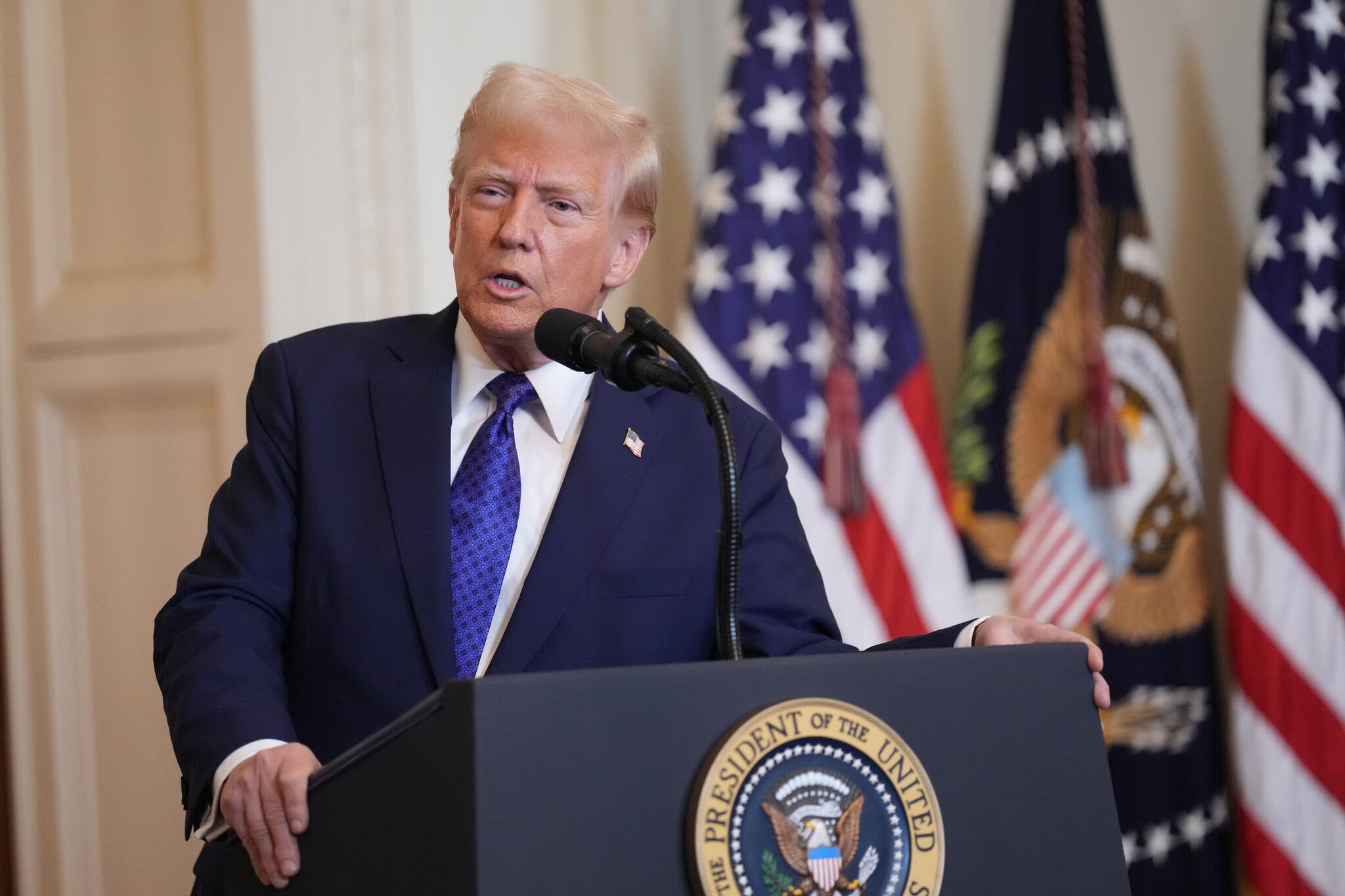Trump Administration's China Tariffs: A 2025 Outlook

Table of Contents
The initial aim of the Trump Administration's China Tariffs was to address significant trade imbalances and combat what the administration deemed unfair trade practices, particularly intellectual property theft. These tariffs targeted a wide range of Chinese goods, aiming to pressure China into negotiating more favorable trade agreements. However, the actual consequences have been complex and far-reaching, requiring a comprehensive analysis to fully grasp their impact.
The Initial Impact of the Tariffs (2018-2020)
The immediate aftermath of the tariff imposition saw significant disruption across various sectors. American agriculture, particularly soybeans and pork, experienced substantial losses due to reduced Chinese imports. Manufacturing industries, heavily reliant on imported components from China, faced increased production costs, leading to price hikes and reduced competitiveness. The technology sector also felt the pinch, with tariffs on electronic components and other goods impacting production and supply chains.
The economic consequences were felt on both sides of the Pacific. US GDP growth experienced a slight deceleration, while China also witnessed a slowdown in its economic expansion. Job losses in some US sectors were reported, although other sectors saw growth as domestic production was stimulated. China retaliated with its own tariffs on US goods, escalating the trade war and further complicating the global economic landscape.
- Industries Heavily Affected: Agriculture (soybeans, pork), manufacturing (electronics, textiles), technology (semiconductors, consumer electronics).
- Trade Volume Changes: Significant decline in bilateral trade volume between the US and China during the initial phase of the tariffs.
- Retaliatory Tariffs: China imposed retaliatory tariffs on various US goods, including agricultural products and manufactured goods.
The Biden Administration's Approach to China Tariffs
President Biden inherited the complex legacy of the Trump-era tariffs. While he hasn't fully removed them, his administration has adopted a more nuanced approach. The Biden administration appears to be prioritizing strategic engagement with China, focusing on addressing specific concerns rather than a blanket approach of widespread tariffs. This strategy involves targeted negotiations and a focus on areas such as technology, human rights, and climate change. The removal or modification of certain tariffs has been implemented on a case-by-case basis, aiming to achieve specific policy goals.
- Policy Changes: Phased removal of some tariffs, initiation of targeted trade negotiations, increased focus on strategic competition with China.
- Ongoing Trade Negotiations: Discussions continue on various trade issues, including intellectual property rights, market access, and technology transfer.
- Political Pressures: Balancing the need for economic stability with geopolitical considerations regarding China significantly influences policy decisions.
Long-Term Economic Consequences of the Tariffs
The long-term ramifications of the Trump Administration's China Tariffs extend beyond immediate economic shocks. Supply chains have been significantly disrupted, leading to increased costs and delays. Global trade patterns have shifted, with companies exploring alternative sourcing options, including reshoring and nearshoring. Inflation in the US has been exacerbated by increased import costs, impacting consumer prices. Furthermore, the trade war has deepened the existing mistrust between the US and China, complicating broader geopolitical relations beyond pure trade issues.
- Reshoring and Nearshoring Trends: Companies are relocating production facilities closer to their home markets to reduce reliance on China.
- Long-Term Impact on Industries: Certain industries may struggle to regain competitiveness after the disruption caused by tariffs.
- Predictions Regarding Trade Deficits: The long-term impact on US trade deficits is uncertain, with potential for both increases and decreases depending on future policy decisions and economic growth.
Predicting the Tariff Landscape in 2025
Predicting the state of the Trump Administration's China Tariffs in 2025 requires considering several factors. While complete removal seems unlikely in the short term, significant modifications are plausible. The extent of these changes will depend on the trajectory of US-China relations, technological competition, global economic stability, and domestic political pressures in both countries. A continued escalation of geopolitical tensions could lead to the persistence or even expansion of existing tariffs. Conversely, progress in trade negotiations and a more cooperative global economic environment could result in a significant reduction or removal of tariffs.
- Potential Scenarios: Partial removal, complete removal, maintenance of existing tariffs, or even expansion of tariffs to new sectors.
- Impact on Economies: Each scenario will have a different impact on economic growth, inflation, and employment in both the US and China.
- Future Trade Negotiations: The outcome of future negotiations will heavily influence the final state of the tariffs.
Conclusion: The Future of Trump Administration's China Tariffs
The Trump administration's China tariffs have had profound and multifaceted consequences, impacting global trade, supply chains, and US-China relations. While the short-term economic effects were felt across various sectors, the long-term implications continue to unfold. By 2025, we anticipate a landscape significantly shaped by the Biden administration's approach. While complete removal seems unlikely, a significant modification or targeted reduction is more probable, depending on the evolving geopolitical dynamics and economic conditions. The legacy of these tariffs will undoubtedly be a defining element of the ongoing US-China relationship for years to come.
To stay informed about future adjustments to the Trump Administration's China Tariffs and their ongoing impact on the US-China trade relationship, continue to follow reputable news sources and economic analysis. Resources from think tanks and government agencies provide valuable insights into this complex and evolving situation.

Featured Posts
-
 Indian Businesses And Consumers Boycott Pakistan Turkey And Azerbaijan
May 18, 2025
Indian Businesses And Consumers Boycott Pakistan Turkey And Azerbaijan
May 18, 2025 -
 Rave Events A Significant Contributor To Local Economies
May 18, 2025
Rave Events A Significant Contributor To Local Economies
May 18, 2025 -
 Tna Sacrifice Results Mooses Injury And The Hardys Next Challenge
May 18, 2025
Tna Sacrifice Results Mooses Injury And The Hardys Next Challenge
May 18, 2025 -
 The Red Soxs Bullpen Upgrade Impact Of The Cardinals Trade
May 18, 2025
The Red Soxs Bullpen Upgrade Impact Of The Cardinals Trade
May 18, 2025 -
 New Orleans Jail Security Breach Inmate Escape Video Surfaces
May 18, 2025
New Orleans Jail Security Breach Inmate Escape Video Surfaces
May 18, 2025
Latest Posts
-
 The Fsu Shooting Uncovering The Victims Fathers Cia Connection
May 18, 2025
The Fsu Shooting Uncovering The Victims Fathers Cia Connection
May 18, 2025 -
 Family Of Fsu Shooting Victim A Legacy Of Exile And Espionage
May 18, 2025
Family Of Fsu Shooting Victim A Legacy Of Exile And Espionage
May 18, 2025 -
 Fsu Shooting Victims Fathers Cia Past Revealed
May 18, 2025
Fsu Shooting Victims Fathers Cia Past Revealed
May 18, 2025 -
 Performance Bonus Double For Michael Morales At Ufc Vegas 106
May 18, 2025
Performance Bonus Double For Michael Morales At Ufc Vegas 106
May 18, 2025 -
 Ufc Vegas 106 Michael Morales Secures Second Consecutive Performance Bonus
May 18, 2025
Ufc Vegas 106 Michael Morales Secures Second Consecutive Performance Bonus
May 18, 2025
